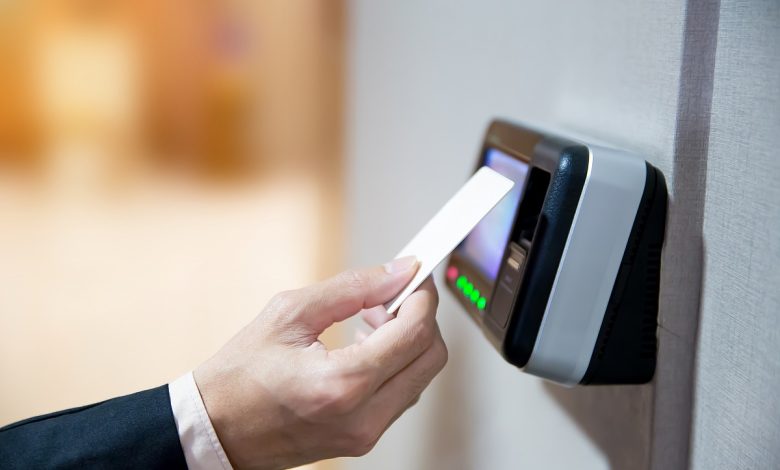Is RFID Door Access System Safer to Use than NFC?

Wireless technologies such as Radio Frequency Identification (RFID) and Near-Field Communication (NFC) are becoming increasingly popular for businesses in a variety of industries who are looking to improve their door access system, asset tracking and inventory management.
These technologies offer a number of benefits over traditional methods, including greater accuracy, real-time data, and the ability to track assets across multiple locations.
Trying to decide between RFID and NFC readers for your business’s door access system can seem like a daunting task. Both have their benefits, so it ultimately comes down to what you value more for your business and what your target market is looking for.
Radio Frequency Identification (RFID)
RFID stands for Radio Frequency Identification. This technology uses electromagnetic waves to capture and read transmitted data. RFID tags, like the one on your credit card, hold electronic data. In the case of access control, these RFID tags hold the credential information that, when placed near a compatible reader, will transmit the info to unlock the door.
RFID tags can be either active or passive. Active RFID tags have their own power source and can work at a longer range than passive RFID tags. Passive RFID tags are powered by the reader and have a shorter range.
Both types of RFID tags can be detected from several feet away by the receiver, making them useful for access control in buildings with a high number of cardholders. RFID is an increasingly popular solution for indoor access control systems.
By RFID-enabling employee ID cards or providing employees with special access cards for their office, companies can quickly and easily deploy an access control solution that allows for unique credentials. This can help to improve security and ensure that only authorized personnel have access to specific areas.
How It Works
The RFID applications that are used for personnel identification usually operate at a low frequency, almost 140 kHz. This is for badge detection. The information about the cardholder, object, or reader is electronically stored in the RFID cards or tags. These tags can only store small pieces of information, like identification numbers, prices, or codes.
Just like your door reader at home, these RFID readers work by sending out radio waves and detecting any RFID tags or cards within range. RFID tags can come in all shapes and sizes, but they usually have a range of around 10 centimeters to 1 meter. The RFID reader decodes the info from the tag and sends it to the host software. The software then either grants or denies access to the user.
RFID Software
The access control software system is responsible for managing access approvals. Signals are received from each RFID reader, and the readers can accept or deny requests to access certain amenities based on access levels or specific permissions.
Access panels make it easy to control who can come and go into buildings or rooms. They work with RFID readers to track access requests and make sure that only authorized people can get through doors or locks. To use an access panel, you’ll need some hardware like a card reader or controller.
Pros and Cons
RFID chips are a lot more durable than the old barcode-based access cards. That means you don’t have to spend as much time and money replacing them because they can take a beating.
They also work in almost any kind of weather, which is great if you have outdoor readers that are exposed to the elements. And because RFID tags are so popular, they’re extremely reliable for security and compatibility purposes.
While RFID cards have a lot of benefits, there are a few potential drawbacks to using them as well. For example, any person with an RFID reader could access the information on the card.
The tag doesn’t choose when it’s transmitting data, so it can’t tell the difference between a legitimate and illegitimate reader. Additionally, RFID cards can be interrupted by electromagnetic interference, which means they might not work properly after a while.
Near Field Communication (NFC)
NFC technology is based on RFID and has many similarities, but also a few key differences. NFC smart tags are most commonly associated with smartphones, which can act as both receivers and transmitters of data.
This type has a shorter range than RFID – it only works within about four inches of another NFC-enabled device. NFC is used in many applications in the modern world, especially for access control in cloud computing, physical access control, system security, and property security.
How It Works
NFC access control can be used to replace the need for badges, keys, or fobs. The principle of NFC technology is the same as RFID in that it allows for data to be transmitted securely over short distances.
Like RFID, a smart card can be used to send information to NFC-enabled devices, such as tablets, mobile phones, and laptops. This allows them to access cloud-based networks and system resources over the internet.
NFC door access control systems are becoming increasingly popular due to their convenience and ease of use. Rather than having to carry around a physical key or badge, users can simply use their smartphone as their credential.
When the smartphone is held near the NFC reader, a communication channel is established and data transactions take place, authenticating the permissions of the user to access the secured area, resources, or applications.
NFC Software
NFC door access is able to record and store all of the information that is transmitted via NFC. This information can be used to create more insightful access control logs.
The information that is recorded includes time, any user information, and the length of the event. All of this information can be compiled and organized to create informative reports that improve security and streamline audits.
Pros and Cons
Smartphone-based NFC credentials are more cost effective than traditional keycards because you don’t have to provision new keycards for every new hire or for old or lost cards. Instead, users can bring their own device to use as a credential.
Smartphone credentials also increase your security posture because smartphones require some version of an unlock to occur before they will activate NFC data transmission.
NFC has a lot of great benefits when it comes to door access technology, but it’s important to keep in mind that it doesn’t work for smart cards and readers that are more than a few inches apart.
If you run a busy, high-volume space, this can be a challenge when you just want to get as many people through the door as possible. In this case, RFID can be the preferable option.
Key Takeaway
It can be tough to decide which door access system is best for your organization, but it’s important to weigh the pros and cons of each option. With RFID and NFC, you have to consider factors like security, ease of use, and accessibility. Ultimately, the best decision is the one that best meets the needs of your organization.


